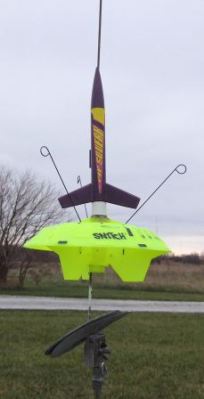| Manufacturer: | Modification |
 Brief:
Brief:
What do you get when you rummage through the build pile 2 nights before a 2009 challenge deadline trying to come up with stage bash ideas? The answer is the decidedly low-labour Pipsnitch, a saucer-based screamer. It made use of one of the many clearance-sale Snitch's I'd picked up at about $3 apiece, and a quick-to-build Quest Pipsqueak.
Construction:
Ingredients:
- 1 Estes Snitch (RTF, stock kit)
- 1 Quest Snitch
I started with the Snitch, finished "stock" which just involved adding the metal antennae/landing gear.
Before building the Pipsqueak, I knew I'd need some means of mounting it to the Snitch, and was hoping the stuffer tube could be used. As it turns out, that's also the motor tube and so shortening that could lead to problems. I decided instead to trim off about 3/4" of the TT-20 main body tube, and epoxied that to the top of the Snitch.
I built the rest of the Pipsqueak stock, though cut off the metal motor hook as it would interfere with the stage coupler mounting.
The aft end of the Pipsqueak has the BT-20 motor tube extending about 3/8" from the TT-20 main tube, and this is inserted into the small piece of TT-20 mounted to the top of the Snitch for the staging configuration.
Finishing:
The Snitch was pre-finished in dayglo yellow plastic. The Snitch got a rushed paint job of one coat of primer, two coats of Rustoleum purple, then peel N stick decals the next afternoon once the paint had mostly cured.
Flight:
As I'd run out of time, procrastinating about as much as I could get away with, I was stuck with less than ideal flying conditions--overcast and winds blowing 15-20 mph. It was either that, or a night launch after work, so I loaded the Snitch with a B6-0 and the Pipsqueak with an A8-3 figuring that was abut as mild a first flight as I could attempt.
Saucers in general tend to weathercock pretty strongly in moderate winds, even more so with another rocket stuck on its head. Almost immediately after clearing the rod, my Pipsnitch started arcing over into the wind, quickly settling into a horizontal flight pattern. The A8-3 lit fine, finishing off the cruise missile imitation. Even with the short -3 delay, it had already coasted to the ground at ejection.
Recovery:
The Snitch tumbled fine, and the Pipsqueak didn't get a chance to test out the streamer.
Summary:
Despite the poor flight in adverse weather conditions, I do feel confident in the design and staging adaptation, and think this approach will be fine in lighter winds. I also think this basic approach could be used as a simple staging technique for many other sustainer models. I will surely need to fly it on a calmer day to prove out, but think I've found a decent use for some of those Snitches I'd accumulated,
#Related Reviews
Related Products
Sponsored Ads
 |
 |











